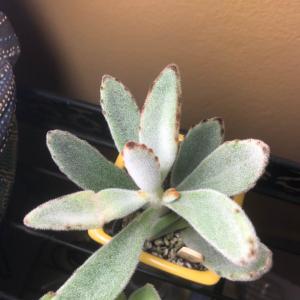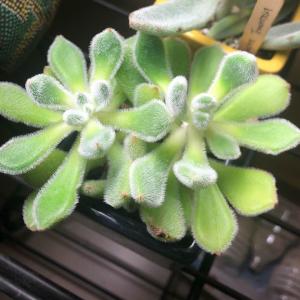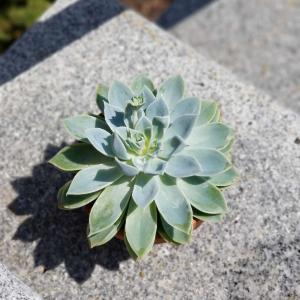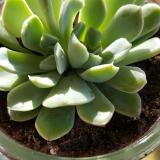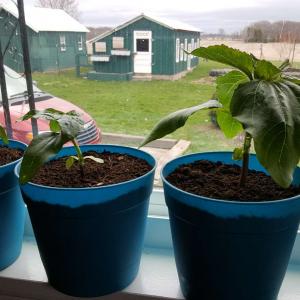文章
Miss Chen
2018年04月28日

Both watermelons (Citrullus lanatus) and cantaloupes (Cucumis melo) are members of the cucumber family, Cucurbitaceae. These annual vines with long, sprawling stems take up a large area in a garden and need lots of sunshine and warm temperatures to produce well. Honeybees pollinate the plants' flowers, but the pollen from watermelon and cantaloupes do not create hybrid fruits.

Size
The foremost concern in planting both cantaloupe and watermelons in the same garden bed is space. The vines of both melons spread far and will grow wherever they can to access sunlight. Plants too close together cause unnecessary competition for light, soil moisture and nutrients. Dense vegetation may also lead to humid conditions on the soil surface and increase fungal diseases. If space is an issue, modern varieties include some bush-types which mature with short vines and may be more suitable to the dimensions of your garden.
Pollination
Closely related vegetable vines like pumpkins, gourds and squashes cross-pollinate each other's flowers and can yield awkward, inconsistent hybrid fruits. Watermelons and cantaloupes do not cross-pollinate each other. However, according to Virginia Cooperative Extension, you should expect different varieties of cantaloupes, honeydews and muskmelons to cross-pollinate each other within close range in the garden. Depending on genetics, this may lead to fruits with variable fruit qualities that aren't always desirable.
Disease and Pest Concerns
Since watermelons and muskmelons are susceptible to many of the same pests and diseases, growing both crops in a garden bed may be problematic. For example, if the watermelon is attacked by stem borers and not treated, the pest can quickly spread and harm nearby cantaloupe vines. Potential disease problems exist, including threats from alternaria blight, bacterial wilt, fusarium wilt, leaf spot and powdery and downy mildews. Cucumber beetles, squash vine borers, pickleworms and squash bugs also attack both plants. Cucumber beetles tend to spread the bacterial wilt disease around the garden.

Growing Tips
Watermelons and cantaloupes can grow and produce well in the same spacious garden bed. If the gardener remains conscientious about monitoring for weeds, disease and insect pests, any potential major cultural problems can be avoided or treated. Encourage a chemical-free garden so honeybees and bumblebees pollinate the melon flowers. Also consider placing developing melon fruits on a piece of scrap plywood to keep them from resting directly on the moist garden soil. This prevents rot and can assist in limiting access of insects to the ripening fruits.

Size
The foremost concern in planting both cantaloupe and watermelons in the same garden bed is space. The vines of both melons spread far and will grow wherever they can to access sunlight. Plants too close together cause unnecessary competition for light, soil moisture and nutrients. Dense vegetation may also lead to humid conditions on the soil surface and increase fungal diseases. If space is an issue, modern varieties include some bush-types which mature with short vines and may be more suitable to the dimensions of your garden.
Pollination
Closely related vegetable vines like pumpkins, gourds and squashes cross-pollinate each other's flowers and can yield awkward, inconsistent hybrid fruits. Watermelons and cantaloupes do not cross-pollinate each other. However, according to Virginia Cooperative Extension, you should expect different varieties of cantaloupes, honeydews and muskmelons to cross-pollinate each other within close range in the garden. Depending on genetics, this may lead to fruits with variable fruit qualities that aren't always desirable.
Disease and Pest Concerns
Since watermelons and muskmelons are susceptible to many of the same pests and diseases, growing both crops in a garden bed may be problematic. For example, if the watermelon is attacked by stem borers and not treated, the pest can quickly spread and harm nearby cantaloupe vines. Potential disease problems exist, including threats from alternaria blight, bacterial wilt, fusarium wilt, leaf spot and powdery and downy mildews. Cucumber beetles, squash vine borers, pickleworms and squash bugs also attack both plants. Cucumber beetles tend to spread the bacterial wilt disease around the garden.

Growing Tips
Watermelons and cantaloupes can grow and produce well in the same spacious garden bed. If the gardener remains conscientious about monitoring for weeds, disease and insect pests, any potential major cultural problems can be avoided or treated. Encourage a chemical-free garden so honeybees and bumblebees pollinate the melon flowers. Also consider placing developing melon fruits on a piece of scrap plywood to keep them from resting directly on the moist garden soil. This prevents rot and can assist in limiting access of insects to the ripening fruits.
1
0
文章
Miss Chen
2018年04月28日

Most garden vegetables prefer well-drained loamy soil with a neutral pH. However, in many parts of North America, especially the Appalachian Mountains and other hilly regions, good drainage can be difficult to find. Clay soils produce stunted growth and encourage fungal diseases, such as root rot. Amending your soil with additives or choosing vegetables that grow well in this type of soil increase your chances of a healthy, productive garden.

Potatoes
According to the English Gardening website, potatoes are a traditional crop for breaking up clay soils. These plants grow in a wide range of soils, although they prefer gardens high in organic matter with a relatively acid pH. Adding compost or other organic material improves potato yields and ashes or peat decreases pH, since alkaline soils lead to potato scab disease. Potatoes reduce compaction in your clay-soil garden, making the environment friendlier for other vegetables. Avoid early varieties, as clay soils stay colder in spring than other soil types.

Peas
These plants grow well in just about any soil from clay to sand, as long as they have adequate drainage. They prefer slightly acidic to slightly alkaline soils with pH from pH 6 to pH 7.5. However, they will grow in soils with stronger acidity or alkalinity. Avoid overwatering when growing peas on clay, as too much water encourages wilt and root rot diseases. After harvest, cut the plants at soil level, leaving the roots in the ground to add nitrogen and organic material to the soil. This improves drainage and soil quality.

Cabbage
Cabbage and other members of the Brassica family grow well in soils ranging from loam to silty clay. They tolerate intermediate levels of salt, which sometimes build up in clay soils after extensive fertilizer use. They grow best in the cool season. As with potatoes, choose cabbages and cabbage relatives that grow during the late spring and summer, as clay soils often remain too cold for early planting.
Considerations
Even plants that do well in clay soil prefer good drainage and high fertility. Amending your clay-based soil makes it friendlier to clay-loving garden vegetables and improves yield. Adding organic materials, such as compost, manure and peat, gives your soil better nutrition and reduces the chance of water pooling. Include grass clippings, dead garden plants and organic yard waste in the fall to compost over the winter. Avoid adding sand, since the result actually compacts more easily and firmly than clay alone.

Potatoes
According to the English Gardening website, potatoes are a traditional crop for breaking up clay soils. These plants grow in a wide range of soils, although they prefer gardens high in organic matter with a relatively acid pH. Adding compost or other organic material improves potato yields and ashes or peat decreases pH, since alkaline soils lead to potato scab disease. Potatoes reduce compaction in your clay-soil garden, making the environment friendlier for other vegetables. Avoid early varieties, as clay soils stay colder in spring than other soil types.

Peas
These plants grow well in just about any soil from clay to sand, as long as they have adequate drainage. They prefer slightly acidic to slightly alkaline soils with pH from pH 6 to pH 7.5. However, they will grow in soils with stronger acidity or alkalinity. Avoid overwatering when growing peas on clay, as too much water encourages wilt and root rot diseases. After harvest, cut the plants at soil level, leaving the roots in the ground to add nitrogen and organic material to the soil. This improves drainage and soil quality.

Cabbage
Cabbage and other members of the Brassica family grow well in soils ranging from loam to silty clay. They tolerate intermediate levels of salt, which sometimes build up in clay soils after extensive fertilizer use. They grow best in the cool season. As with potatoes, choose cabbages and cabbage relatives that grow during the late spring and summer, as clay soils often remain too cold for early planting.
Considerations
Even plants that do well in clay soil prefer good drainage and high fertility. Amending your clay-based soil makes it friendlier to clay-loving garden vegetables and improves yield. Adding organic materials, such as compost, manure and peat, gives your soil better nutrition and reduces the chance of water pooling. Include grass clippings, dead garden plants and organic yard waste in the fall to compost over the winter. Avoid adding sand, since the result actually compacts more easily and firmly than clay alone.
0
0
文章
Miss Chen
2018年04月28日

Dozens of bell pepper varieties in an array of colors can be grown in your home vegetable garden each summer. Bell peppers can can grow in all U.S. Department of Agriculture hardiness zones and tolerate a variety of climatic conditions. However, because they are a warm-season vegetable, they do best with a long growing season, the Iowa State University Extension reports. Regular applications of fertilizer can benefit the plants, bettering your odds for a healthy harvest.

Before Planting
Pre-treat the soil where you will plant bell peppers with a 5-10-5 fertilizer. Apply 2 to 3 pounds for every 100 square feet of garden space, the Iowa State University Extension advises. Alternately, have your soil tested prior to planting to see what specific needs your soil has and whether it would benefit from a different fertilizer.
After Transplanting
Once you transplant pepper plants outdoors, treat them with water-soluble fertilizer. The Iowa extension recommends using a water-soluble fertilizer or making your own solution by mixing 2 tbsp. of a 10-10-10 fertilizer in 1 gallon of water. Each plant should receive between 1 and 2 cups of the fertilizer.

After Fruiting
As your bell peppers grow, they will need at least one more fertilizer application. Wait until the plants set their first young peppers before applying fertilizer, the University of Illinois Extension reports. Use the same fertilizer you applied after the plants were set in the soil and repeat every three or four weeks. Always follow manufacturer's directions carefully to ensure you don't apply too much.
Application Technique
When fertilizing bell peppers and many other garden vegetables, side-dress the plants to prevent damage to the stems and leaves. To do this, apply fertilizer to the soil several inches away from the plant stem, Fort Valley State University recommends. Water the plants thoroughly afterwards, so the fertilizer incorporates into the soil.

Before Planting
Pre-treat the soil where you will plant bell peppers with a 5-10-5 fertilizer. Apply 2 to 3 pounds for every 100 square feet of garden space, the Iowa State University Extension advises. Alternately, have your soil tested prior to planting to see what specific needs your soil has and whether it would benefit from a different fertilizer.
After Transplanting
Once you transplant pepper plants outdoors, treat them with water-soluble fertilizer. The Iowa extension recommends using a water-soluble fertilizer or making your own solution by mixing 2 tbsp. of a 10-10-10 fertilizer in 1 gallon of water. Each plant should receive between 1 and 2 cups of the fertilizer.

After Fruiting
As your bell peppers grow, they will need at least one more fertilizer application. Wait until the plants set their first young peppers before applying fertilizer, the University of Illinois Extension reports. Use the same fertilizer you applied after the plants were set in the soil and repeat every three or four weeks. Always follow manufacturer's directions carefully to ensure you don't apply too much.
Application Technique
When fertilizing bell peppers and many other garden vegetables, side-dress the plants to prevent damage to the stems and leaves. To do this, apply fertilizer to the soil several inches away from the plant stem, Fort Valley State University recommends. Water the plants thoroughly afterwards, so the fertilizer incorporates into the soil.
0
0









